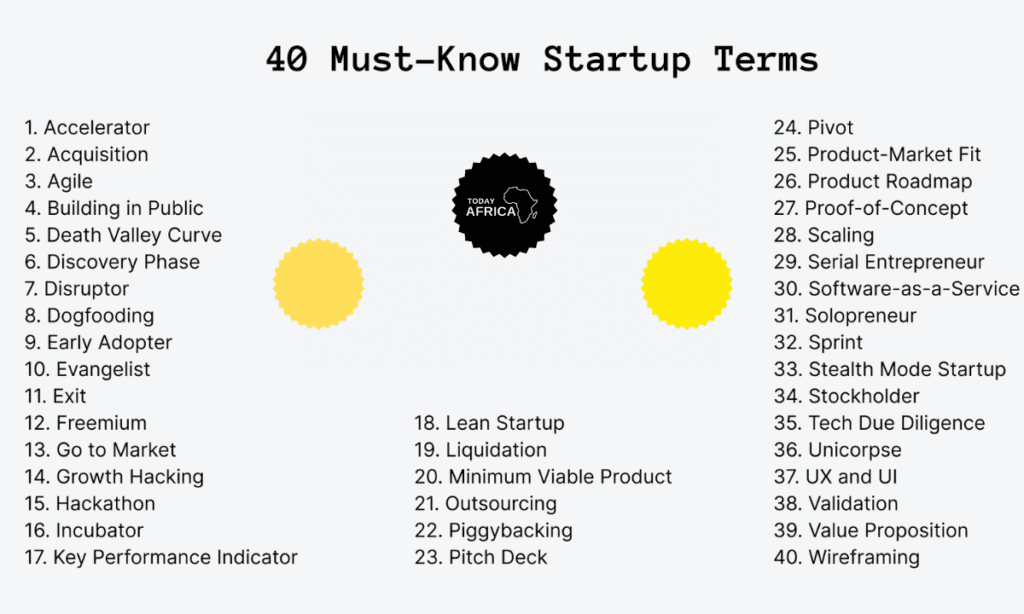The number of must-know startup words is growing by the year, and it might get tough for entrepreneurs to keep up with the emerging startup terminology.
So to make sure you’re aware of the meaning of many popular terms used in the field, we’ve decided to put together a mini startup terminology dictionary.
Below you’ll find a list of commonly-used startup terms with simple explanations.
Startup Terminology: 39
1. Accelerator
Startup founders often turn to organizations that can support them in their growth. As such, there are incubators and accelerators. Although both options are aimed at aiding entrepreneurs, they differ in duration, provided assistance, application terms, etc.
2. Acquisition
In a broad business sense, acquisition is the process of purchasing a business, which often results in a company merging. On the other hand, customer acquisition refers to the process of obtaining clients who buy your product or service.
3. Agile
Agile is a product management and software development approach that divides the project into phases focusing on continuous collaboration between multiple parties and ongoing refinement.
Unlike the traditional Waterfall method, agile is iterative and customer-focused, aiming to complete functional code units quickly.
In agile, projects are broken down into features or microservices that need to be developed. The project timeline is comprised of sprints, each typically lasting from one to four weeks.
4. Building in public
Building in public involves the process of openly sharing the entire journey of creating a product or business with the public. In contrast to stealth startups, which keep their operations a secret.
Build in public startups regularly provide updates on social media about their progress, fails, and wins. The main objective is to stir up interest around the product attracting engaged followers, eager to give feedback and contribute to further enhancements.

4. Death valley curve
Death Valley curve refers to a period in a startup’s life that begins from the moment it obtains its initial capital funding to the point where it starts bringing profits.
During this phase, startups frequently face considerable challenges and financial difficulties, which, in the worst scenarios, can lead to high startup failure rates.
However, overcoming the death valley curve is a positive sign for investors signaling that the company has become self-sustainable. This makes it a more attractive investment opportunity, raising the chances of succeeding in startup fundraising.
5. Discovery phase
The project discovery phase, or scoping, is the stage that goes after idea initiation and before development works start. It includes research and proof of concept, defining the target audience and forming the product vision, choosing the tech stack, selecting the features, and planning the overall work ahead.
In short, this stage is devoted to ensuring that the product is worth building and planning how to do it most effectively. It provides you with the opportunity to reduce product and startup risks. And follows a more precise development plan that’ll allow for creating a better product in shorter time frames.
6. Disruptor
A disruptor is also part of the frequently used startup terminology. A disruptive startup is a company that revolutionizes an existing industry or establishes a brand-new market with innovative approaches. These businesses enter the market with groundbreaking products or services that alter the way customers utilize a particular product.
7. Dogfooding
Dogfooding is a startup terminology which means the practice of using a company’s own products or services internally before releasing them to the public. This approach allows the startup to accelerate beta testing and gain internal feedback required for further refinement.
By giving your product to your own team, you can address issues and fine-tune your product version way sooner, rather than waiting for customer reviews to spot bugs and flaws. This step can be integral both for a soft and hard launch.
8. Early adopter
Early adopters are the pioneers who explore the product before it becomes popular, often your first customers. Customarily, these are the people who start using your services or product before you reach a broader audience.
Undoubtedly, early adopters are very important for products that are only shaping. Such “consumers” may present valuable feedback and can be the moving force in spreading the word about the solution.
9. Evangelist
These are the ambassadors of a product who, for the most part, are in the company’s ecosystem. Who can be an evangelist? The startup founder, members of the board, employees, team members, etc.
Basically, anyone who is capable of getting you more supporters and convincing people that the product is valuable and should be “adopted”. On rare occasions, people who aren’t part of the company are considered evangelists.
There are multiple ways evangelists can promote the product or startup, including:
- product awareness activities;
- educating people;
- attending conferences;
- presenting the company at meetings

10. Exit
Exit is when a startup founder leaves the company by selling his share or passes ownership due to a sale.
Numerous startups actually build startups for the purpose of making a successful exit in due time, meaning they want to sell it for a very good profit.
If this is the case, there’s a startup exit plan for the startup to get acquired or an exit strategy to sell a stake. Usually, the product goes through a thorough audit, where its quality is assessed.
10. Freemium
A freemium is a pricing strategy that offers a part of the product at no cost. As a rule, this customer acquisition model can provide users partial access to only basic functionality, whereas the more intricate solutions, add-ons, features, or services come at an extra charge when opting for the paid plan.
11. Go to market (GTM)
A go-to-market strategy is a company’s plan that indicates how they’ll win their target customers and promote the created product after release. It may include various points like the promotion tactics, the utilized channels, the startup’s pricing strategy and pricing model that’ll be adopted, and other campaigns.
12. Growth hacking
Growth hacking refers to a combination of startup growth strategies aimed at driving quick and effective business and product growth. The main goal is to get the maximum number of customers while spending as little as possible. The strategy includes:
- utilizing the best available tech and;
- trying new channels;
- keeping an eye on emerging global trends in business;
- choosing various marketing techniques;
- using analytics and data for decision-making;
- holding experiments, testing, and validating hypotheses.
13. Hackathon
Hackathon is an event where a group of startup founders, developers, designers, or other participants get together to brainstorm innovative ideas and create solutions in a limited period of time.
14. Incubator
As briefly mentioned above, accelerators and incubators differ. An incubator is a program for early-stage startups that assists founders as they take their first steps. The application process is rather simple, and the duration of “stay” is unlimited.
15. Key performance indicator (KPI)
Key performance indicators are evaluation criteria chosen by a company to measure its progress toward achieving set goals. The set of KPIs differs from company to company based on its aims, priorities, and business initiatives.
16. Lean startup
A lean startup focuses on delivering a product as quickly as possible with minimal investment. This “trial and error” approach implies testing the ideas and experimenting with the product by making corresponding adjustments and iterations “on the go” as a way to discover its flaws and ways to improve it.
17. Liquidation
Liquidation is the process of shutting down a company and selling off its assets to settle debts with creditors and stakeholders. This usually happens when a startup is unable to continue its operations due to financial difficulties, bankruptcy, or other issues.
18. Minimum viable product (MVP)
Giving a short minimum viable product definition, it’s a simple yet functioning pilot version of the product. Unlike a demo or prototype, an MVP is a solution that works and can be used by clients. Nonetheless, it’s a shrunken version of the product that is yet to become full-fledged and feature-rich.
19. Outsourcing
Outsourcing means obtaining a service or passing work to a third party on a contract basis. For instance, not all tech startups can afford to employ a qualified team of developers to build their product or a specific feature. They can lack certain talent or an entire development department. So they choose to team up with an outsourcing provider or hire a dedicated software development team that’ll work as though it’s a part of the company.
20. Piggybacking
Piggybacking is the process of using or taking advantage of an existing system, product, or service to build or fine-tune your own solution. For instance, a tech startup might leverage a popular software platform to develop an app that seamlessly integrates with it.
On another note, piggybacking on a more successful company or business partner is a cost-saving strategy, as two companies collaborate and mutually represent each other in the market. This way, both companies can reduce development and marketing costs while expanding their market presence and credibility.
21. Pitch Deck
This is vital startup terminology every founder should know. A pitch deck (also referred to just as “deck”) is a presentation of the startup. It is used when a startup is in search of funding or financial support.
22. Pivot
A startup pivot means making fundamental changes in the strategy, direction, product, or business model to breathe new life into your company. This typically occurs when a product fails to meet customer expectations, and the founders recognize that the topical approach isn’t driving progress. The purpose of a pivot is to bring in more revenue and take the product to the next level.
23. Product-market fit (PMF)
Even the best ideas might not receive the expected acceptance. Lack of market need is one of the top reasons explaining why so many startups close down. Therefore, it is crucial to do your research and find product-market fit no matter what. It’s a continuous process, and it surely isn’t limited to pre-product-launch research.
Read Also: 25 Funding Terms Every Startup Founder Should Know
Having PMF means that the product is of decent quality and the audience is buying and making use of it. Such a product brings value, has a steady sales stream, many returning buyers, good feedback, and a growing client base. This also often means that the customers are recommending the product to others, aiding its further adoption thanks to word-of-mouth promotion.
24. Founder-market fit
Founder-market fit is a startup terminology that ensures that the founders have a deep understanding of the product’s market and are skilled enough to create a product that meets customer needs. When both founder-market fit and product-market fit are present, the startup is likely to grow and scale successfully.
25. Product roadmap
Successful software development projects are ones that are well-planned and organized. Therefore, creating a roadmap implies crafting a document that describes the product-to-be so that everyone stays on track.
Product roadmap provides the big picture and includes a summary of the major aspects such as the:
- product vision
- goals to be accomplished
- key features of the product with feature prioritization
- needed resources
- planned activities
- stages and timeline
- who is responsible for what
26. Proof-of-concept (POC)
Proof-of-concept (POC) involves market and user research to find out whether the product is worth creating. This idea validation stage is used to prove the feasibility of a product idea or feature creation, as well as the project’s viability. POC is also needed to confirm that the product can be brought to life, at least in the way you think.
27. Scaling
Defining other startup vocabulary words, scalability is all about a company’s or product’s potential for growth and expansion. It also means that it’s sustainable and has a good chance of evolving into something bigger.
Importantly, startup scaling differs from the classic growth scenario as growth usually happens according to the invested resources (for instance, money spent on additional hires when scaling the team or getting technological upgrades). Scaling, on the other hand, doesn’t rely on large investment, instead expansion takes place thanks to business process optimization or automation.
28. Serial entrepreneur
A serial entrepreneur is someone who repeatedly starts and grows multiple businesses throughout their career. Unlike a traditional entrepreneur who focuses on building and scaling one venture, a serial entrepreneur is an expert at finding new business opportunities and continuously launches new startups, often in different industries or markets.
29. Software-as-a-service (SaaS)
Companies offering SaaS application development services or some software-as-a-service create and sell digital products that are available on Internet-connected devices. Such on-demand products are web-hosted, are often offered based on subscription, and come in a variety of shapes and sizes.
30. Solopreneur
This startup terminology describes a person who has founded a business and runs it on their own. That is, no one else is helping them manage and grow the business. They handle all the company-related matters independently without external support, employees, or co-founders.
31. Sprint
Sprints are focused, short-term periods lasting between one week to one month, during which a team works to complete a particular task. Each sprint has clearly defined goals that should be achieved by the end of it.
32. Stealth mode startup
A stealth mode startup refers to a company that keeps a new project under wraps until its launch. This secrecy helps to protect innovative ideas and prevent the dismissal of an idea. During this period, the company typically operates discreetly, avoiding public announcements, press releases, or startup marketing activities. The goal is to create buzz around the product once it’s released.
33. Stockholder
A stockholder, also referred to as a shareholder, is someone who possesses a company’s shares (or specific corporate ownership units). This means that they get profit or dividends from these stocks and may have a vote when major decisions are made. They differ from stakeholders who have other forms of interest in the company apart from stocks.
34. Tech due diligence
Tech due diligence involves a thorough evaluation of a product’s or company’s technology, systems, and processes to assess their viability, security, and scalability. It’s all about examining the technology stack, software architecture, data management practices, and development methodologies.

35. Unicorpse
Unlike a unicorn – a flourishing business that has a startup valuation of over 1$ billion. A unicorpse refers to a startup that once was highly valued or successful but has significantly dropped in value or even failed and gone bankrupt. This decline can be due to various factors such as market shifts, operational challenges, or strategic missteps.
36. User experience (UX) and user interface (UI)
User experience is responsible for providing an intuitive interaction with the product, making it easy for a person to browse, use, or take any expected action. It must be logical, answer to user needs and expectations, and not have excessive steps or non-user-friendly elements that would ruin the perception.
User interface is responsible for the appearance of the product and the elements that form the user journey. All details and touchpoints (buttons, scrolls, droplists, etc.) should be visually accessible and simple to engage with.
37. Validation
Validation usually involves conducting market research, analyzing competitors and industry trends, identifying customers’ pain points, and validating the selected tech stack and core functionality. The key purpose of the validation process is to confirm whether your idea is feasible by going through proof of concept and proof of value along with other key steps.
38. Value proposition
A value proposition can also be listed among the startup terminologies. It includes the unique selling points that a product offers and explains what makes your product stand out and how it solves an existing problem. This is what makes a product or feature attractive to potential customers, giving them a reason to choose, use, or purchase it.
39. Wireframing
Mentioning other startup terms to know, UX wireframing is one of the first design stages used to outline the structure of the future solution.
Final Thoughts
So there we have it, a startup terminology to help you learn the ropes and speak the entrepreneurial language. If you know the meaning of all the terms in our list of frequently used startup jargon, give yourself a pat on the back!
If you found this article useful, we’d love to hear from you! Drop your thoughts in the comments below. And don’t forget to connect with us on our social media channels for more tech tips and valuable content. Join our community and stay updated on all the latest insights!
- Facebook: Today Africa
- Instagram: Today Africa
- Twitter: Today Africa
- LinkedIn: Today Africa
- YouTube: Today Africa Studio
















